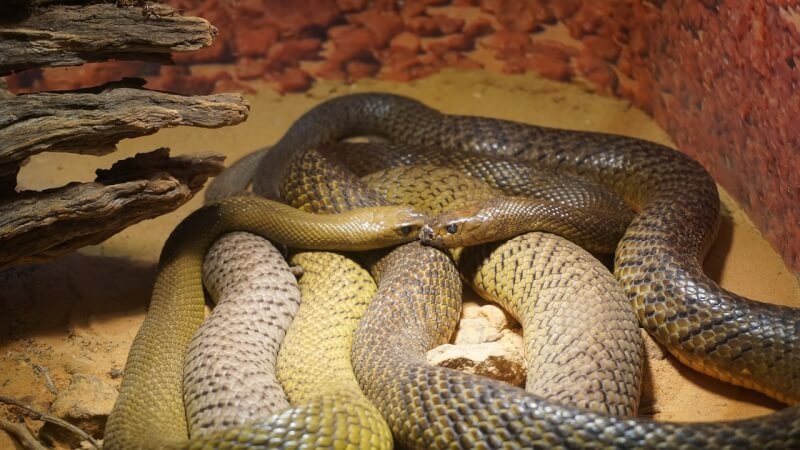Snakes, fascinating creatures known for their stealth and slithering movements, have a form of communication that may surprise you. While they may lack the ability to produce vocal sounds or rely on facial expressions like mammals, snakes have developed unique ways to convey messages to their fellow serpents. Through a combination of body language, pheromones, and subtle movements, these elusive reptiles are able to communicate important information such as aggression, mating interest, and even the presence of prey. Discover the intricate world of snake communication and unravel the hidden ways in which they successfully convey their intentions and needs to one another.

Chemical Communication
Introduction to Chemical Communication
When it comes to communication, snakes have developed a fascinating method utilizing chemicals. Chemical communication involves the use of chemical signals to convey information between individuals. These signals can be transmitted through an array of mechanisms, such as scent marking or specific chemical compounds. This mode of communication plays a crucial role in various aspects of snake behavior, including mate selection, territorial marking, and even prey detection.
Chemical Signals
Snakes possess specialized scent glands located in various parts of their bodies, such as the cloaca or chin. These glands produce pheromones, which are chemical substances that carry specific information for other snakes. Pheromones can convey messages related to reproductive status, dominance, or even threat levels. Each snake species has its unique combination of pheromones, allowing for precise communication within their respective communities.
Scent Marking
Scent marking is an essential component of chemical communication for snakes. By leaving their scent in the environment, snakes can establish their territories and communicate with other individuals. They achieve this by rubbing their bodies against objects, leaving behind their unique pheromones. Snakes can also produce scent trails when moving, allowing other snakes to track their presence and gain valuable information about their whereabouts.
Sexual Attraction and Reproduction
Chemical signals also play a vital role in snake reproduction. Female snakes release specific pheromones to attract potential mates during the mating season. Male snakes then use their specialized sensory organs, known as Jacobson’s organ, to detect these pheromones. This sense of smell guides males towards the females, facilitating successful mating. Additionally, pheromones can help determine the receptiveness of female snakes, ensuring that mating occurs at the most suitable time.
Visual Communication
Introduction to Visual Communication
While chemical communication is prominent in snakes, visual cues also play a significant role in their communication repertoire. Visual communication involves the use of body language, coloration, and patterns to convey information and establish social interactions.
Body Language
Snakes utilize various body postures and movements as a means of communication. For example, when feeling threatened, a snake may flatten its body, creating an S-shaped curve commonly known as the “S-curve defensive posture.” This posture serves as a warning signal to potential predators or other snakes, indicating the snake’s readiness to defend itself.
Coloration and Patterns
The coloration and patterns exhibited by snakes can serve multiple purposes in their communication. Brightly colored or highly contrasting patterns are often a form of warning signal, indicating venomous or dangerous properties. These patterns help potential predators or other animals recognize the snake’s potential danger and warn them to keep their distance. On the other hand, snakes may also use coloration and patterns for camouflage, allowing them to blend seamlessly into their surroundings, thereby improving their chances of survival.
Territorial Displays
Snakes may exhibit territorial displays to establish and defend their territories. These displays can involve specific body movements, such as raising the head or displaying a hood (as seen in cobra species). By visually demonstrating their presence and dominance, snakes communicate their territorial boundaries to other individuals, preventing conflicts and reducing the likelihood of aggression.

Auditory Communication
Introduction to Auditory Communication
While snakes are not well-known for their voice-boxes, they can still communicate through auditory signals. Auditory communication in snakes primarily revolves around vocalizations and unique sounds produced by specific species.
Vocalizations
Certain snake species, such as the rat snake or king cobra, are capable of producing hissing sounds as a form of communication. Hissing is often associated with displaying aggression, indicating that the snake is preparing to defend itself. This intense and unmistakable sound sends a clear message to potential threats, warning them to stay away.
Rattlesnake Rattle
One of the most iconic auditory signals in the snake world is the rattlesnake’s rattle. This distinctive sound is produced by the shaking of specialized segments at the tip of the snake’s tail. The rattle serves as both a warning and a defensive signal, indicating the presence of a venomous snake. The distinct sound created by the rattle alerts potential predators or humans to the snake’s presence, allowing them to proceed with caution and avoid any potential conflict.
Tactile Communication
Introduction to Tactile Communication
In addition to chemical, visual, and auditory communication, snakes also engage in tactile communication. Tactile communication involves the use of physical contact or vibrations to convey information to other snakes.
Vibrations
Snakes have an acute sense of detecting vibrations in their environment. By perceiving these vibrations, they can gain valuable insights into their surroundings, such as the presence of nearby prey or potential threats. This sense of touch allows snakes to navigate their environment effectively and respond swiftly to changes in their surroundings.
Physical Contact
Physical contact is another form of tactile communication utilized by snakes, particularly during courtship and mating. Male snakes may engage in gentle physical interactions with females, such as nudging or rubbing against them, to signal their reproductive intentions. These tactile cues provide important information to the female snake, helping her determine whether the male is a suitable mate.
Tongue Flicking
Snakes possess a unique organ called the Jacobson’s organ, located in the roof of their mouths. This organ allows them to process and interpret chemical cues in their environment. Snakes flick their tongues, picking up scent particles from the air or objects, and then bring their tongues back into their mouths to transfer these particles to the Jacobson’s organ. Through tongue flicking, snakes gain information about their surroundings and potential prey or predators.
Social Behavior and Signals
Introduction to Snake Social Behavior
Although often perceived as solitary creatures, snakes do exhibit social behaviors and engage in various signaling methods to communicate and interact with each other.
Mating Rituals
Snake mating rituals can be elaborate and involve complex dance-like movements. Male snakes may engage in intricate courtship dances, using their bodies and specific motions to attract the attention of female snakes. These rituals serve to demonstrate the male’s fitness, genetic quality, and ability to provide suitable offspring.
Courtship Displays
In addition to mating rituals, snakes also employ courtship displays to communicate their intentions. These displays can involve specific body movements, such as intertwining or coiling around each other. By engaging in these elaborate displays, snakes communicate their willingness to mate and establish a positive connection with the potential mate.
Group Behavior
While most snakes are primarily solitary, there are a few exceptions where they exhibit social behaviors and engage in group activities. For example, some snake species may gather together in communal hibernation sites during cold months to conserve body heat. This group behavior allows snakes to benefit from shared warmth and improved chances of survival during harsh conditions.
Aggression and Defense Signals
Introduction to Aggression and Defense Signals
When threatened or faced with aggression, snakes employ a variety of signals and behaviors to defend themselves. These signals serve as warnings to potential predators or other snakes, indicating the snake’s readiness to defend and potentially retaliate.
S-curve Defensive Posture
One of the most common defense signals displayed by snakes is the S-curve defensive posture. When feeling threatened, a snake will flatten its body and create an S-shaped curve by elevating its head and upper body off the ground. This posture serves to intimidate and warn potential predators or threats, signaling that the snake is prepared to defend itself if necessary.
Head-Butting
In some instances, snakes may resort to head-butting as a defensive mechanism. This aggressive behavior involves striking the head against the potential threat, using their solid and durable skull to neutralize or deter attackers. Head-butting serves as a direct signal of aggression, demonstrating the snake’s willingness to engage in physical combat if necessary.
Warning Displays
Snakes may also employ warning displays to communicate their ability and willingness to defend themselves. These displays can involve expanding the hood (as seen in cobras), shaking the tail (as seen in rattlesnakes), or even puffing up the body to appear larger and more intimidating. Such warning displays communicate to potential predators the snake’s venomous nature or ability to inflict harm, serving as a deterrent to avoid any potential conflict.
Chemical Detection and Tracking
Introduction to Chemical Detection and Tracking
Snakes possess an exceptional sense of smell, allowing them to detect and track chemical signals emitted by other snakes, prey, or their surrounding environment. This ability is crucial for communication and survival.
Jacobson’s Organ
The Jacobson’s organ is a specialized sensory organ located in the roof of a snake’s mouth. This unique organ detects and analyzes chemical cues picked up by the snake’s tongue flicking behavior. Through this organ, snakes can sense and interpret pheromones released by other snakes, enabling them to gather valuable information about potential mates, rivals, or threats.
Following Scent Trails
Snakes can trace scent trails left by other snakes or prey using their remarkable sense of smell. By following these trails, snakes can locate and track the movement of other individuals, providing them with valuable information about their community dynamics, territorial boundaries, or potential food sources.
Prey Location
Chemical communication also aids snakes in locating prey. Snakes can detect chemical signals released by their prey, allowing them to pinpoint their location accurately. By relying on their exceptional sense of smell, snakes optimize their hunting strategies and increase their chances of successfully capturing their next meal.
Infrared Sensing
Introduction to Infrared Sensing
In addition to their impressive chemical and visual communication abilities, some snake species possess the remarkable sense of infrared detection. This unique sense allows snakes to perceive heat signatures and aids in various aspects of survival.
Pit Organs
Snakes possessing infrared sensing capabilities have specialized structures called pit organs located between their eyes and nostrils. These pit organs are highly sensitive to thermal radiation emitted by warm-blooded prey, predators, or even environmental heat sources. By detecting the heat signatures, snakes can determine the location, size, and distance of potential targets, providing them with a significant advantage in hunting and predator avoidance.
Heat Detection
The ability to sense heat through infrared detection enables snakes to identify and locate warm-blooded prey species accurately. Snakes can detect even subtle temperature variations, allowing them to differentiate between warm-blooded animals and their surrounding environment. This precise heat detection enables snakes to effectively strike and seize their prey, maximizing their hunting success.
Predator Avoidance
Infrared sensing also plays a vital role in the defense mechanisms of snakes. By detecting the heat signatures of potential predators, snakes can assess the threat level and implement appropriate evasion strategies. This heightened awareness of thermal cues allows snakes to react swiftly and navigate their environment without risking confrontation with dangerous predators.
Environmental Communication
Introduction to Environmental Communication
Snakes also communicate valuable information related to their environment and internal states. Environmental communication involves behaviors and signals associated with maintaining an optimal habitat, regulating body temperature, and establishing daily habits.
Temperature Regulation
Snakes are ectothermic creatures, meaning their body temperature depends on the surrounding environment. To regulate their body temperature effectively, snakes need to communicate information related to optimal temperature ranges within their habitat. By exhibiting specific behaviors in response to temperature changes, snakes signal their preference for specific microclimates or seek out suitable locations for thermoregulation.
Thermoregulatory Behavior
Snakes engage in thermoregulatory behavior by actively seeking out and utilizing different temperature zones within their habitat. By moving between warm and cool areas, snakes can maintain an optimal body temperature for various physiological functions. These thermoregulatory behaviors indicate the snake’s ability to adapt to temperature fluctuations and serve as a means of communication regarding their thermal requirements.
Habits and Patterns
Snakes also communicate their daily habits and preferred activity patterns through consistent routines and behavior. Some snake species exhibit predictable movement patterns, such as regular basking in the sun or preferred hunting locations. These habits communicate the snake’s preferred activities and help other snakes familiarize themselves with the daily routines within their community.
Limitations and Further Research
Challenges in Studying Snake Communication
While significant progress has been made in understanding snake communication, several challenges remain in studying these fascinating creatures. The secretive nature of snakes, the complexity of their behaviors, and the diverse range of species all contribute to the difficulties in gathering comprehensive data. Researchers face the hurdle of limited access to natural snake habitats, making it challenging to observe and document snake communication in their natural environments.
Current Research and Discoveries
Despite the challenges, ongoing research continues to shed light on snake communication. Scientists employ sophisticated techniques, including genetic analysis, behavior observation, and advanced imaging technologies, to unravel the intricacies of snake signaling. Recent studies have revealed additional insights into the significance of chemical communication, the complexities of visual displays, and the genetic basis of certain communication behaviors.
Unexplored Aspects of Snake Communication
While much progress has been made, there are still many aspects of snake communication that remain unexplored. Further research is needed to deepen our understanding of these remarkable creatures. Topics that warrant further investigation include the intricacies of mating rituals, the role of individual variation in communication, and the potential existence of unique communication systems in less-studied snake species. Continued research holds the promise of uncovering new and exciting discoveries in the realm of snake communication.


